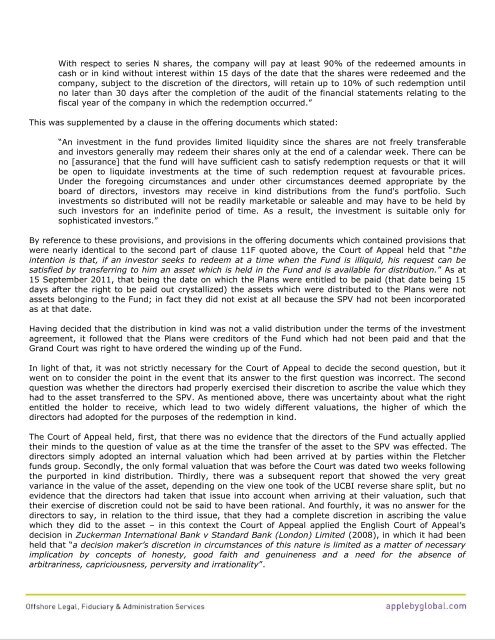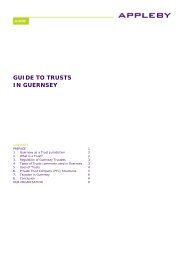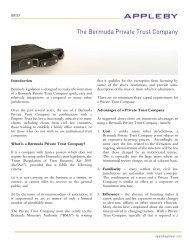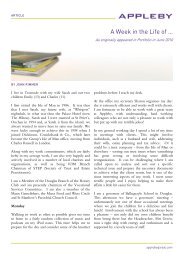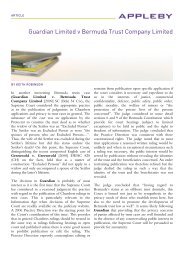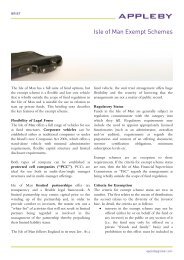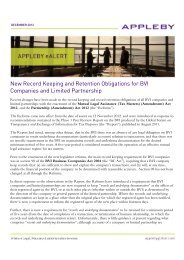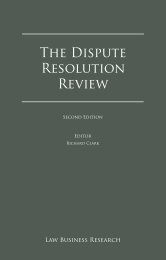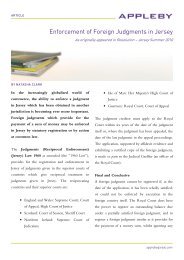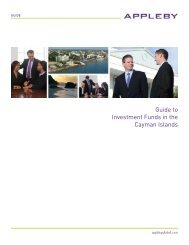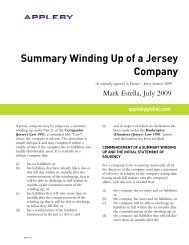FIA Leveraged Fund: The Cayman Court Takes a Strict ... - Appleby
FIA Leveraged Fund: The Cayman Court Takes a Strict ... - Appleby
FIA Leveraged Fund: The Cayman Court Takes a Strict ... - Appleby
Create successful ePaper yourself
Turn your PDF publications into a flip-book with our unique Google optimized e-Paper software.
With respect to series N shares, the company will pay at least 90% of the redeemed amounts incash or in kind without interest within 15 days of the date that the shares were redeemed and thecompany, subject to the discretion of the directors, will retain up to 10% of such redemption untilno later than 30 days after the completion of the audit of the financial statements relating to thefiscal year of the company in which the redemption occurred.”This was supplemented by a clause in the offering documents which stated:“An investment in the fund provides limited liquidity since the shares are not freely transferableand investors generally may redeem their shares only at the end of a calendar week. <strong>The</strong>re can beno [assurance] that the fund will have sufficient cash to satisfy redemption requests or that it willbe open to liquidate investments at the time of such redemption request at favourable prices.Under the foregoing circumstances and under other circumstances deemed appropriate by theboard of directors, investors may receive in kind distributions from the fund's portfolio. Suchinvestments so distributed will not be readily marketable or saleable and may have to be held bysuch investors for an indefinite period of time. As a result, the investment is suitable only forsophisticated investors.”By reference to these provisions, and provisions in the offering documents which contained provisions thatwere nearly identical to the second part of clause 11F quoted above, the <strong>Court</strong> of Appeal held that “theintention is that, if an investor seeks to redeem at a time when the <strong>Fund</strong> is illiquid, his request can besatisfied by transferring to him an asset which is held in the <strong>Fund</strong> and is available for distribution.” As at15 September 2011, that being the date on which the Plans were entitled to be paid (that date being 15days after the right to be paid out crystallized) the assets which were distributed to the Plans were notassets belonging to the <strong>Fund</strong>; in fact they did not exist at all because the SPV had not been incorporatedas at that date.Having decided that the distribution in kind was not a valid distribution under the terms of the investmentagreement, it followed that the Plans were creditors of the <strong>Fund</strong> which had not been paid and that theGrand <strong>Court</strong> was right to have ordered the winding up of the <strong>Fund</strong>.In light of that, it was not strictly necessary for the <strong>Court</strong> of Appeal to decide the second question, but itwent on to consider the point in the event that its answer to the first question was incorrect. <strong>The</strong> secondquestion was whether the directors had properly exercised their discretion to ascribe the value which theyhad to the asset transferred to the SPV. As mentioned above, there was uncertainty about what the rightentitled the holder to receive, which lead to two widely different valuations, the higher of which thedirectors had adopted for the purposes of the redemption in kind.<strong>The</strong> <strong>Court</strong> of Appeal held, first, that there was no evidence that the directors of the <strong>Fund</strong> actually appliedtheir minds to the question of value as at the time the transfer of the asset to the SPV was effected. <strong>The</strong>directors simply adopted an internal valuation which had been arrived at by parties within the Fletcherfunds group. Secondly, the only formal valuation that was before the <strong>Court</strong> was dated two weeks followingthe purported in kind distribution. Thirdly, there was a subsequent report that showed the very greatvariance in the value of the asset, depending on the view one took of the UCBI reverse share split, but noevidence that the directors had taken that issue into account when arriving at their valuation, such thattheir exercise of discretion could not be said to have been rational. And fourthly, it was no answer for thedirectors to say, in relation to the third issue, that they had a complete discretion in ascribing the valuewhich they did to the asset – in this context the <strong>Court</strong> of Appeal applied the English <strong>Court</strong> of Appeal’sdecision in Zuckerman International Bank v Standard Bank (London) Limited (2008), in which it had beenheld that “a decision maker’s discretion in circumstances of this nature is limited as a matter of necessaryimplication by concepts of honesty, good faith and genuineness and a need for the absence ofarbitrariness, capriciousness, perversity and irrationality”.


